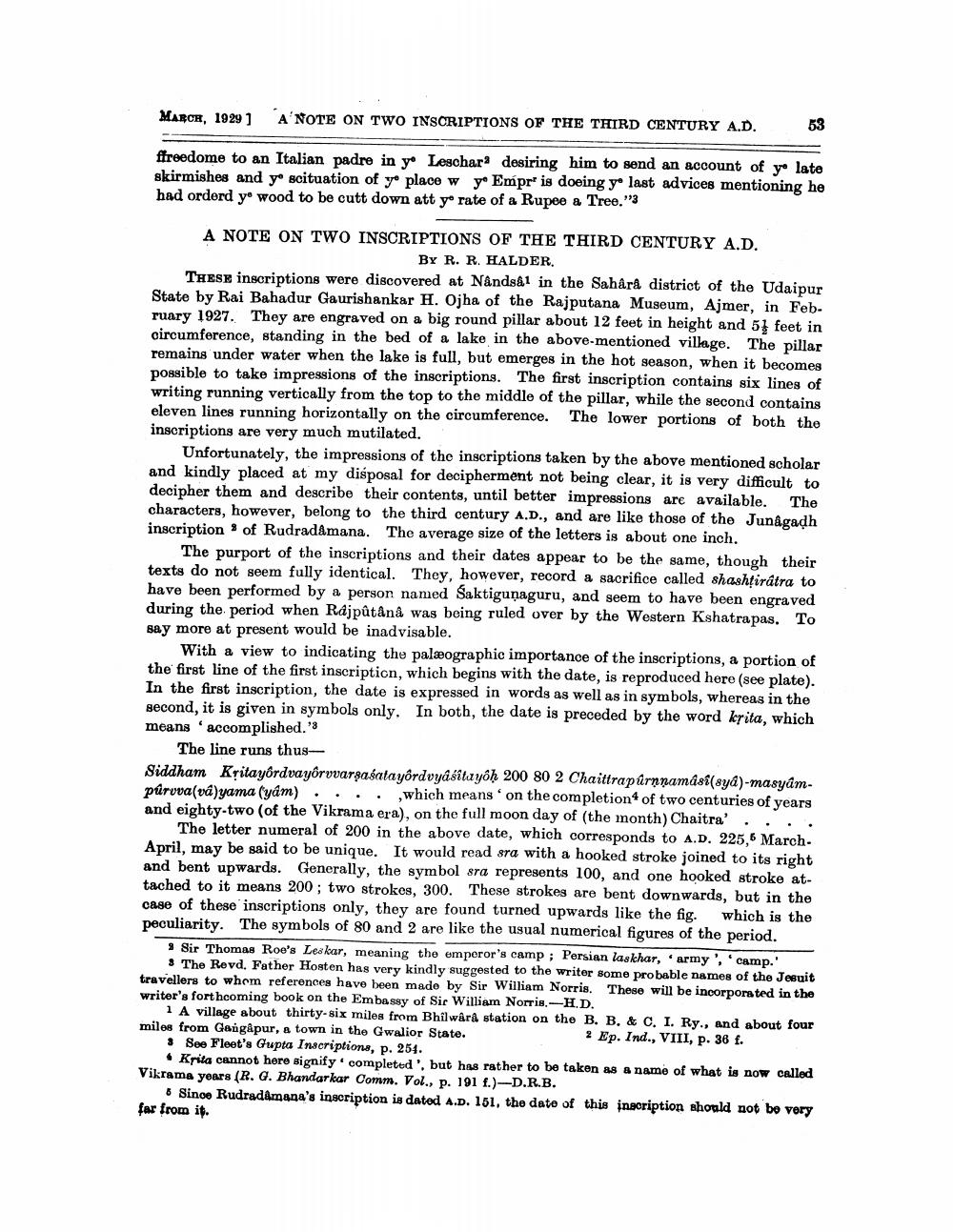________________
MARCH, 1929]
ANOTE ON TWO INSCRIPTIONS OF THE THIRD CENTURY A.D.
53
ffreedome to an Italian padre in yo Leschar desiring him to send an account of yo late skirmishes and y situation of ye place w y Empr' is doeing y last advices mentioning he had orderd y wood to be cutt down att y rate of a Rupee a Tree."3
A NOTE ON TWO INSCRIPTIONS OF THE THIRD CENTURY A.D.
BY R. R. HALDER. THESE inscriptions were discovered at Nândsâl in the Sahârå district of the Udaipur State by Rai Bahadur Gaurishankar H. Ojha of the Rajputana Museum, Ajmer, in Feb. ruary 1927. They are engraved on a big round pillar about 12 feet in height and 5} feet in circumference, standing in the bed of a lake in the above-mentioned village. The pillar remains under water when the lake is full, but emerges in the hot season, when it becomes possible to take impressions of the inscriptions. The first inscription contains six lines of writing running vertically from the top to the middle of the pillar, while the second contains eleven lines running horizontally on the circumference. The lower portions of both the inscriptions are very much mutilated.
Unfortunately, the impressions of the inscriptions taken by the above mentioned scholar and kindly placed at my disposal for decipherment not being clear, it is very difficult to decipher them and describe their contents, until better impressions are available. The characters, however, belong to the third century A.D., and are like those of the Junagadh inscription % of Rudradamana. The average size of the letters is about one inch.
The purport of the inscriptions and their dates appear to be the same, though their texts do not seem fully identical. They, however, record a sacrifice called shashtirátra to have been performed by a person named Saktigunaguru, and seem to have been engraved during the period when Rajpûtânå was being ruled over by the Western Kshatrapas. To say more at present would be inadvisable.
With a view to indicating the palæographic importance of the inscriptions, a portion of the first line of the first inscription, which begins with the date, is reproduced here (see plate). In the first inscription, the date is expressed in words as well as in symbols, whereas in the second, it is given in symbols only. In both, the date is preceded by the word krita, which means 'accomplished.'
The line runs thusSiddham Kritayôrdvayôrvvargasatayôrdvyásitayoḥ 200 80 2 Chaittrapūrnnamási(syd)- masyâmpúruva(vá)yama (yam).... , which means on the completion of two centuries of years and eighty-two (of the Vikrama era), on the full moon day of the month) Chaitra'....
The letter numeral of 200 in the above date, which corresponds to A.D. 225,6 March April, may be said to be unique. It would read sra with a hooked stroke joined to its right and bent upwards. Generally, the symbol sra represents 100, and one hooked stroke at. tached to it means 200; two strokes, 300. These strokes are bent downwards, but in the case of these inscriptions only, they are found turned upwards like the fig. which is the peculiarity. The symbols of 80 and 2 are like the usual numerical figures of the period.
Sir Thomas Roe's Les kar, meaning the emperor's camp ; Persian laskhar, army camp.'
3 The Revd, Father Hosten has very kindly suggested to the writer some probable names of the Jesuit travellers to whom references have been made by Sir William Norris. These will be incorporated in the writer's forthcoming book on the Embassy of Sir William Norris.-H.D.
1 A village about thirty-six miles from Bhilwârå station on the B. B. & C. I. Ry., and about four miles from Gangapur, a town in the Gwalior State.
2 Ep. Ind., VIII, p. 36 f. 3 See Fleet's Gupta Inscriptions, p. 254.
• Kpita cannot here signify completed', but has rather to be taken as a name of what is now called Vikrama years (R. G. Bhandarkar Comm. Vol., p. 191 f.)-D.R.B.
6 Since Rudrad&mana's inscription is dated A.D. 151, the date of this inscription should not be very far from it.




